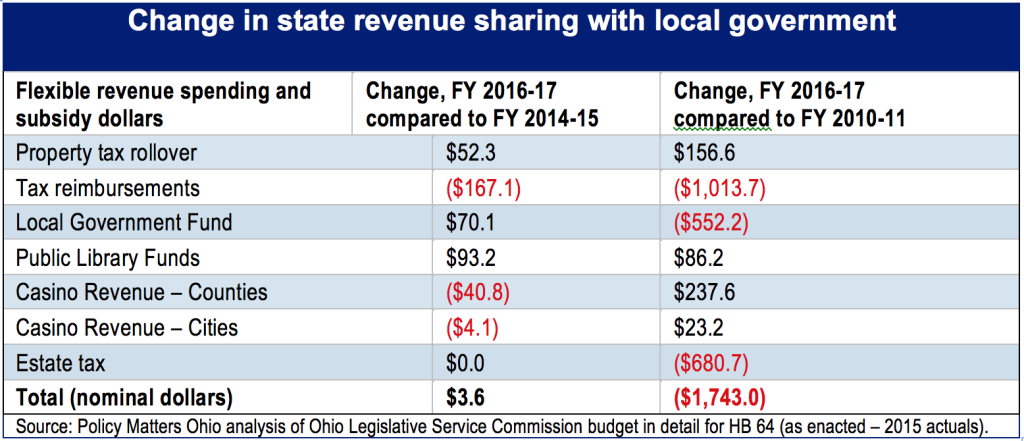
State budget hammers local governments -- again
August 24, 2015
State budget hammers local governments -- again
August 24, 2015
Ohio’s new two-year budget continues a long-term trend of the Kasich administration and General Assembly underfunding needed services of local government.
For the past four years, the state has forsaken its historical partnership with cities, villages and townships. Between cuts in revenue sharing and loss of the estate tax, the state has provided local governments $1.7 billion less in the current, two-year budget than in the 2010-11 budget. That was the last budget in which the historical fiscal partnership between the state and localities was intact. In constant dollars, with inflation accounted for, the loss is more than $2 billion over this time period.
Ohio is a home rule state. Services provided in other places by the state are provided locally in Ohio. That is why the fiscal partnership between the levels of government developed. Priorities and needs differ in our rural and agricultural areas and our many cities and suburban areas. Revenue sharing allows localities to provide services tailored to the needs of their unique local economies and communities. This is what is undercut as the state walks away from the fiscal pact.
Under the new budget for fiscal years 2016-2017, local governments see a tiny bump -- $3.6 million -- from the prior two-year budget. But that’s because of a small and welcome restoration in revenue shared with libraries, which were cut deeply in 2009. Libraries are an earmarked use, so it is fair to say that in terms of flexible resources to support all the other public services a community needs, the budget provides $85.6 million less than the prior budget.
 The cuts have deepened even as the value of taxable property across the state has failed to rebound to pre-recession levels. As a result, police and firefighters have been laid off; recreation facilities cut back or closed; in some places, streetlights were dimmed to save on utility bills.
The cuts have deepened even as the value of taxable property across the state has failed to rebound to pre-recession levels. As a result, police and firefighters have been laid off; recreation facilities cut back or closed; in some places, streetlights were dimmed to save on utility bills.
Yet Gov. Kasich called on cities and counties to raid their own budget reserves for cash, even as he socks another $500 million in state resources away in the state rainy day fund.
Who suffers? Teens who use recreation centers for swimming, basketball and social activities. Homeowners whose wealth is eroded by decay strapped cities can’t afford to repair. Citizens who depend on good roads and swift emergency services.
Who benefits? Fully half of the $2 billion income tax cuts in the two-year budget bill goes to the 1 percent of Ohioans earning at least $388,000 a year. They tend not to live in neighborhoods where teens depend on recreation centers for safe social activity, and they tend not to live in towns that have unrepaired potholes and inadequate police protection.
This time, there was an added twist of the knife to cities. Forty million dollars in local government funds was diverted from cities to townships or earmarked for specific uses. However worthwhile the earmarked activities are, those funds are needed for basic public services. One set of strapped jurisdictions was tapped to support another set of strapped jurisdictions. It would be less ironic if the tax cuts and reserve savings in the budget were not so large.
For most Ohioans, the outcome of these priorities impacts daily lives in ways that diminish wealth, curtail opportunity and reduce quality of life in their community.
-- Wendy Patton
Wendy is Policy Matters senior project director.
Tags
2015Budget PolicyLocal GovernmentRevenue & BudgetWendy PattonPhoto Gallery
1 of 22
